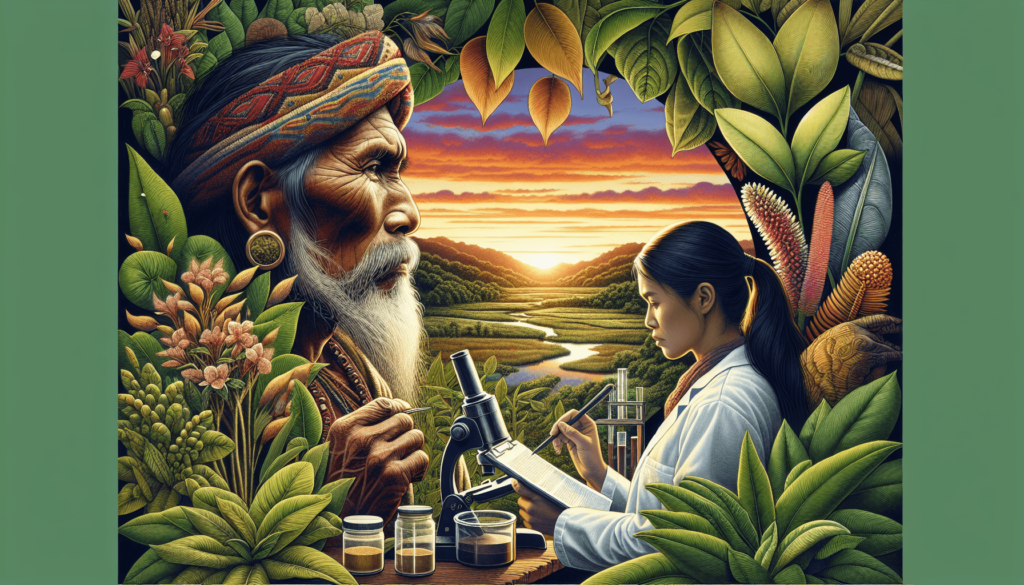So you’re curious about the fascinating field of ethnobotany? Well, you’re in for a treat! Ethnobotany is the scientific study of how different cultures and communities interact with plants. From ancient remedies and herbal medicine to traditional food and cultural practices, ethnobotany explores the intricate relationship between humans and plants. It’s a field that combines biology, anthropology, and botany to uncover the vast knowledge that indigenous communities have amassed over centuries. So let’s embark on a journey to unravel the secrets of ethnobotany and discover the invaluable wisdom hidden in the plant world.

Definition and Scope of Ethnobotany
Definition of Ethnobotany
Ethnobotany is the interdisciplinary study that examines the relationship between plants and people, particularly indigenous communities. It explores how plants are used in traditional knowledge systems, including medicine, food, agriculture, and spirituality. Ethnobotany combines the fields of anthropology, botany, ecology, and pharmacology to analyze the dynamic interactions between different cultures and the plant world.
The Scope of Ethnobotany
The scope of ethnobotany is vast and encompasses various aspects of human-plant interactions. It investigates indigenous knowledge systems and the cultural, ecological, and economic significance of plants. Ethnobotanists study traditional ecological knowledge, traditional healing practices, plant-based rituals, sustainable farming techniques, and the conservation of plant biodiversity. Additionally, ethnobotany plays a crucial role in understanding the potential of traditional medicine systems and their integration with modern medicine.
Historical Background of Ethnobotany
Ethnobotany has a rich historical background that spans cultures and continents. Indigenous peoples have been intimately connected with their surrounding plant biodiversity for centuries. Traditional knowledge of plants and their uses has been passed down through generations, providing invaluable insights into their medicinal, nutritional, and cultural properties. European explorers and colonial botanists documented these diverse plant uses during the Age of Discovery, laying the foundations for ethnobotanical research.
Ethnobotanical Research Methods
Collecting and Documenting Indigenous Knowledge
Ethnobotanical research begins with collecting and documenting indigenous knowledge about plants. This involves engaging with local communities and traditional healers to understand their plant-based practices, beliefs, and rituals. Ethnobotanists employ a combination of interviewing, participant observation, and participatory mapping to gather knowledge. It is essential to establish a relationship of trust and respect with these communities to ensure the ethical and responsible collection of their knowledge.
Fieldwork Techniques
Fieldwork is a vital component of ethnobotanical research, as it allows researchers to directly observe and interact with the plants and communities they study. Fieldwork techniques include plant collection, plant identification, ecological surveys, and ethnographic observation. Ethnobotanists often spend extended periods living in the communities they study, immersing themselves in the local culture and learning from traditional practitioners. This hands-on approach enables a deeper understanding of the relationship between people and plants.
Data Analysis in Ethnobotany
Once data is collected through interviews, surveys, and observations, it is analyzed using qualitative and quantitative methods. Qualitative analysis involves coding and categorizing the information obtained from interviews and field notes. Quantitative analysis involves statistical methods to identify patterns and trends within the data. Ethnobotanists also employ Geographic Information Systems (GIS) to map the distribution of plants and explore the spatial relationships between plants and cultural practices.
Ethics and Consent in Ethnobotanical Research
Ethnobotanical research must adhere to ethical guidelines to ensure the respectful and responsible treatment of indigenous knowledge and cultural practices. Obtaining free, prior, and informed consent from the communities being studied is crucial in establishing a mutually beneficial research partnership. Researchers should also prioritize reciprocity, sharing the benefits of their work with the communities and involving them in the research process. Protection of intellectual property rights and avoiding cultural appropriation are essential ethical considerations in ethnobotanical research.
Traditional Knowledge and Indigenous Societies
Traditional Ecological Knowledge
Traditional ecological knowledge (TEK) encompasses the accumulated knowledge and practices of indigenous communities related to the environment. TEK recognizes the interconnectedness of ecosystems, seasons, and the cycles of nature. It includes knowledge about plant identification, sustainable harvesting techniques, habitat management, and the cultural and spiritual importance of plants. TEK provides valuable insights into ecological resilience and offers sustainable solutions to contemporary environmental challenges.
Role of Indigenous Peoples in Ethnobotanical Research
Indigenous peoples play a central role in ethnobotanical research, as their knowledge and experiences are essential for understanding the uses and conservation of plants. Collaboration with indigenous communities ensures that research is conducted with cultural integrity, respect, and reciprocity. Indigenous perspectives enrich scientific understanding and help bridge the gap between traditional knowledge and modern science. By empowering indigenous peoples, ethnobotanical research becomes a powerful tool for cultural revitalization and self-determination.
Preserving and Protecting Indigenous Knowledge
Preserving and protecting indigenous knowledge is crucial in maintaining the cultural heritage and intellectual property rights of indigenous communities. This involves creating mechanisms to prevent the exploitation or misappropriation of traditional knowledge. Collaborative initiatives between indigenous peoples, researchers, and policymakers can lead to the development of protocols and guidelines for the responsible use of traditional knowledge. Documenting and archiving indigenous knowledge in accessible databases ensures its preservation for future generations.

Plants and Their Traditional Uses
Medicinal Plants
One of the most well-known applications of ethnobotanical research is the study of medicinal plants. Indigenous communities have long relied on plants to treat various ailments. Ethnobotanical research allows for the identification, validation, and documentation of medicinal plant knowledge. This knowledge serves as a basis for the development of new pharmaceuticals and the preservation of traditional healing systems. Research in this field has led to the discovery of life-saving drugs, such as quinine for malaria treatment.
Food and Agricultural Practices
Ethnobotany also focuses on the traditional uses of plants for food and agriculture. Indigenous communities have developed sophisticated agricultural systems that rely on local biodiversity, traditional seeds, and sustainable farming techniques. Ethnobotanical research helps preserve traditional agricultural practices and promotes food security. Studying traditional crops and farming methods can also provide insights into climate resilience and sustainable land management.
Cultural and Spiritual Significance of Plants
Plants hold cultural and spiritual significance in indigenous societies. Ethnobotanical research explores the symbolic and ritualistic uses of plants in ceremonies, celebrations, and spiritual practices. Understanding the cultural context and meaning behind plant use deepens our appreciation for the interplay between plants, people, and culture. It also supports efforts to revitalize and protect traditional rituals and ceremonies, which are vital for maintaining cultural identity.
Psychoactive Plants
Psychoactive plants have been used in traditional rituals, ceremonies, and healing practices for centuries. Ethnobotanical research investigates the cultural, spiritual, and therapeutic uses of these plants. By understanding the traditional knowledge and cultural practices surrounding psychoactive plants, researchers can contribute to the responsible and safe use of these substances. Ethnobotanical research also plays a significant role in identifying potential therapeutic compounds for mental health treatments.
Biodiversity Conservation and Sustainable Practices
Conservation of Medicinal Plants
Ethnobotanical research contributes to the conservation of medicinal plants by documenting their traditional uses and ecological importance. By understanding the cultural and economic significance of these plants, researchers can promote sustainable harvesting practices and protect their natural habitats. Collaboration between researchers, communities, and policymakers is crucial in implementing biodiversity conservation strategies that prioritize both ecological sustainability and cultural heritage.
Traditional Farming Techniques
Traditional farming techniques often incorporate sustainable practices that maintain soil fertility, prevent erosion, and promote biodiversity. Ethnobotanical research identifies and documents these techniques, which can help address contemporary agricultural challenges. By integrating traditional farming methods with modern agricultural approaches, researchers can develop more sustainable and resilient farming systems. Sharing and promoting these techniques can contribute to food security, climate adaptation, and the preservation of traditional cultural practices.
Indigenous Land Management
Indigenous land management practices are closely tied to traditional ecological knowledge. Ethnobotanical research examines how indigenous communities have historically managed their lands to promote biodiversity and maintain ecosystem balance. Indigenous land management has been shown to have numerous benefits, including carbon sequestration, habitat restoration, and wildfire prevention. Recognizing the importance and effectiveness of indigenous land management practices can inform sustainable land-use policies and support indigenous land rights.
Ethnobotanical Gardens and Arboreta
Ethnobotanical gardens and arboreta serve as living museums that showcase the cultural and ecological importance of plants. These institutions provide educational opportunities for the public to learn about the traditional uses of plants, their conservation, and the role of indigenous communities in their preservation. Ethnobotanical gardens also serve as centers for research, conservation, and collaboration between scientists, indigenous communities, and the general public.
Traditional Medicine Systems
Ayurveda
Ayurveda is a traditional medicine system originating in India that incorporates plant-based treatments, diet, yoga, and meditation. Ethnobotanical research plays a significant role in validating and documenting the traditional knowledge and efficacy of Ayurvedic treatments. By studying the plants used in Ayurveda, researchers can identify potential bioactive compounds and contribute to the development of evidence-based medicine. Collaboration between Ayurvedic practitioners and scientists can bridge the gap between traditional wisdom and modern healthcare.
Traditional Chinese Medicine
Traditional Chinese Medicine (TCM) has a long history of utilizing plants for health and wellness. Ethnobotanical research explores the diverse plant pharmacopoeia of TCM and investigates the interactions between different medicinal plants. Researchers aim to understand the mode of action of TCM treatments and explore their potential in modern medicine. By integrating TCM practices with Western medicine, ethnobotanical research contributes to a holistic approach to healthcare.
Native American Medicine
Native American Medicine encompasses the traditional healing practices and plant knowledge of Indigenous peoples in North America. Ethnobotanical research focuses on documenting and preserving this traditional knowledge, which includes the use of medicinal plants, spiritual ceremonies, and healing rituals. Collaboration with Native American communities is essential in ensuring the ethical and respectful gathering of traditional knowledge and supporting cultural revitalization efforts.
African Traditional Medicine
African Traditional Medicine (ATM) is a diverse system that incorporates herbal remedies, spiritual practices, and cultural beliefs. Ethnobotanical research in Africa explores the traditional knowledge of plants and their healing properties. This research not only contributes to the validation and preservation of ATM but also identifies potential bioactive compounds for drug discovery. Collaborative efforts between ethnobotanists and traditional healers support the recognition and integration of ATM into national healthcare systems.
Ethnobotany in Modern Medicine
Discovering New Medicinal Compounds
Ethnobotanical research has proven to be a valuable source for the discovery of new medicinal compounds. By studying traditional medicinal plants and their uses, researchers can identify novel bioactive compounds with therapeutic potential. These discoveries have led to the development of life-saving drugs such as antimalarials, anticancer agents, and antibiotics. Ethnobotanical research continues to contribute to drug discovery, providing a foundation for further pharmacological investigations.
Pharmacological Research and Clinical Trials
Ethnobotany serves as a bridge between traditional medicine systems and modern pharmacological research. The traditional uses of plants identified through ethnobotanical research are tested through pharmacological studies to understand their mechanisms of action and potential side effects. Promising plant extracts are further investigated in preclinical and clinical trials to evaluate their safety and efficacy. This integration of traditional knowledge and modern scientific methods ensures evidence-based medicine.
Integration of Traditional Medicine with Western Medicine
Integrative medicine approaches seek to combine traditional medicine systems, such as those identified through ethnobotanical research, with Western medicine. By acknowledging the value of traditional healing practices and plant-based therapies, healthcare systems can provide comprehensive and culturally sensitive care. Integrative medicine bridges the gap between different healing paradigms and allows for a more holistic approach to healthcare that considers both traditional knowledge and modern science.
Challenges and Controversies in Ethnobotany
Intellectual Property Rights
Intellectual property rights and ownership of traditional knowledge can be complex and challenging to navigate. Indigenous communities and traditional healers often hold collective knowledge that is passed down through generations. Protecting this knowledge from misappropriation and ensuring equitable benefit-sharing is an ongoing challenge. Ethnobotanical research must prioritize the recognition and protection of intellectual property rights to prevent exploitation and promote cultural preservation.
Biopiracy and Traditional Knowledge
Biopiracy refers to the unauthorized and unethical exploitation of traditional knowledge and genetic resources. Indigenous communities and traditional healers have often been victims of biopiracy, with their knowledge and resources used for profit without their consent or fair compensation. Ethnobotanical research must be conducted ethically, with a commitment to obtaining free, prior, and informed consent, and respecting indigenous rights over their traditional knowledge and genetic resources.
Cultural Appropriation
Cultural appropriation occurs when aspects of one culture are adopted or used by members of another culture without understanding or respecting their significance. Ethnobotanical research can run the risk of cultural appropriation if conducted without the involvement and consent of the communities being studied. It is crucial for researchers to approach their work with cultural sensitivity, respect, and a commitment to collaboration that empowers indigenous communities.
Ethical Considerations in Commercializing Traditional Knowledge
The commercialization of traditional knowledge raises ethical dilemmas. While the global market for herbal products and traditional medicine is growing, it is essential to ensure that the benefits derived from the commercialization are shared equitably with the communities that hold the traditional knowledge. Ethnobotanical research must navigate the balance between commercial interests, intellectual property rights, cultural integrity, and community empowerment. Establishing fair trade and benefit-sharing agreements is crucial in addressing these ethical considerations.
Case Studies in Ethnobotany
The Use of Quinine in Treating Malaria
The discovery of quinine, an antimalarial compound derived from the bark of the cinchona tree, is a classic example of ethnobotanical research. Indigenous Amazonian communities had long used cinchona bark to treat fevers and shivering associated with malaria. European scientists documented this traditional knowledge, leading to the development of quinine as a potent antimalarial drug. The use of quinine in treating malaria highlights the valuable contributions of traditional medicine to global health.
Traditional Healing Practices in Amazonian Tribes
Amazonian tribes possess profound traditional knowledge of the rainforest’s medicinal plants. Ethnobotanical research in the region has documented the use of plants for treating various ailments and spiritual purification practices. This research has resulted in the identification of novel bioactive compounds and provided a scientific foundation for traditional healing practices. Collaboration between indigenous shamans and scientists has successfully validated traditional knowledge, leading to the recognition and preservation of this ancient healing system.
Sacred Plants in Indigenous Ceremonies
Sacred plants play a central role in indigenous ceremonies and spiritual practices worldwide. Ethnobotanical research explores the cultural significance, preparation methods, and ritualistic uses of these plants. Studying sacred plants allows for a deeper understanding of the cultural and spiritual landscape of indigenous communities. Researchers work closely with traditional practitioners, respecting the sacred nature of these plants and the importance of their proper use within their cultural context.
Traditional Agriculture in Indigenous Communities
Ethnobotanical research sheds light on traditional agricultural practices in indigenous communities. These practices often involve a deep understanding of local ecosystems, sustainable crop rotations, and the use of traditional seeds. Collaborative research with indigenous farmers has led to the recovery and dissemination of valuable agricultural knowledge. Learning from these traditional farming techniques can inform sustainable agricultural practices globally and contribute to food security and environmental conservation.
Future Directions in Ethnobotanical Research
Promoting Collaboration and Partnerships
The future of ethnobotanical research lies in fostering collaboration and partnerships between researchers, indigenous communities, policymakers, and the private sector. Such collaborations can ensure culturally sensitive, ethical, and impactful research. By incorporating diverse perspectives and knowledge systems, researchers can generate innovative solutions to global challenges in health, agriculture, and conservation.
Incorporating Traditional Knowledge into Conservation Strategies
Ethnobotanical research has the potential to inform biodiversity conservation strategies by integrating traditional knowledge into conservation practices. Recognizing the ecological significance of medicinal plants and their role in maintaining ecosystem balance can guide the creation of protected areas and sustainable management plans. Involving indigenous communities in conservation efforts ensures the preservation of cultural heritage while safeguarding plant biodiversity.
Exploring the Potential of Understudied Plants
Ethnobotanical research should focus on understudied plants and traditional knowledge systems that have received limited attention. Many regions and cultures remain vastly unexplored, holding an untapped wealth of knowledge about plant uses and environmental practices. By engaging with these communities and documenting their knowledge, researchers can uncover new plant-based therapies, sustainable farming techniques, and cultural practices that can contribute to human well-being and environmental sustainability.
Addressing Socioeconomic Inequalities in Ethnobotanical Research
Ethnobotanical research should actively address socioeconomic inequalities and power imbalances that exist in research partnerships. Researchers must ensure access to resources, information, and decision-making processes are equitable and inclusive. Supporting capacity-building initiatives, fostering community-led research, and promoting the rights of indigenous peoples are essential steps towards addressing these inequalities. Ethnobotanical research should strive to empower local communities and support their self-determination.

